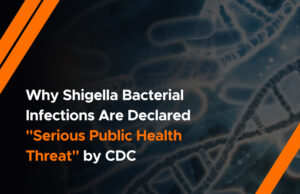Shigella bacteria cause an infection called shigellosis, one of the most common causes of diarrhea in the United States. Shigellosis can be mild or severe, sometimes leading to serious complications such as dehydration, bloody diarrhea, and reactive arthritis. Recently, CDC has pronounced the Shigella Infection as a serious public health threat. Shigella bacteria can be easily transmitted by contact with infected feces or contaminated food or water and can also be spread through sexual contact.
In recent years, the CDC has observed an alarming increase in shigella infections resistant to multiple antibiotics, including those commonly used for empiric and alternative treatment. These extensively drug-resistant (XDR) shigella strains have contributed to the Shigella Infection bring pronounced as a serious public health threat. As they limit treatment options and increase the risk of transmission and complications. This article will discuss the reasons behind this declaration and what it means for public health.
What is Shigella?
Shigella is a type of bacteria that causes shigellosis, a serious intestinal infection that causes an estimated 450,000 infections annually in the United States. The bacteria can infect the colon’s lining and cause inflammation, ulcers, and bleeding. The main symptom of shigellosis is diarrhea, which can be bloody or contain mucus. Other symptoms include fever, abdominal cramps, nausea, and vomiting.
Shigellosis can be spread by direct or indirect contact with the feces of an infected person or animal. To prevent shigellosis, practicing good hygiene and sanitation and avoiding contaminated food and water is important. While antibiotics can be used to treat shigellosis, some strains of shigella are resistant to common drugs. If left untreated, shigellosis can lead to serious complications such as dehydration, malnutrition, and reactive arthritis.
How does Shigella spread?
Shigella bacteria are highly contagious and can infect people through various routes. One of the most common ways is through direct contact with the feces of an infected person or animal, such as when changing diapers, caring for someone sick, or having sexual contact. Another way is indirect contact with objects or surfaces contaminated with shigella bacteria, such as toys, utensils, or doorknobs.
Shigella bacteria can also be transmitted through food and water tainted with fecal matter, such as raw vegetables, fruits, or shellfish. People infected with shigella can shed the bacteria in their stool for several weeks after they recover from their symptoms, and they can infect others who come in contact with their feces.
Why is Shigella a serious public health threat?
Shigella drug resistance is a serious public health threat that limits the available treatment options for shigellosis and increases the risk of complications. According to the Centers for Disease Control and Prevention (CDC), the percentage of drug-resistant Shigella infections has increased from 0% in 2015 to 1% in 2019 and 5% in 2022.
These strains resist five antibiotics recommended to fight shigellosis, including azithromycin, ciprofloxacin, and ceftriaxone. This makes it difficult to treat shigellosis and reduces the effectiveness of antibiotics that help shorten the duration of symptoms and prevent the spread of infection.
Drug-resistant shigellosis can also cause more severe illnesses like dehydration, malnutrition, and reactive arthritis. The highly contagious nature of drug-resistant shigellosis makes it a serious concern, as it can spread easily and rapidly between people, especially through sexual contact or contaminated food and water.
Therefore, monitoring and controlling the emergence and spread of drug-resistant Shigella infections and promoting appropriate antibiotic use and prevention measures are important.
What are the symptoms of Shigella bacterial infections?
Shigella bacterial infections, commonly called shigellosis, are a prevalent cause of diarrheal illness with a wide range of severity. The primary indication of this infection is diarrhea, which can be watery, bloody, or contain mucus or pus and can occur more than ten times a day.
Other symptoms may include stomach pain or cramps, fever, nausea, vomiting, and the urge to pass stool, even with empty bowels. While some individuals may not experience symptoms, they can still transmit the infection to others.
Symptoms generally manifest 1 to 2 days after exposure to the bacteria and last for about a week. However, this may vary depending on the type and amount of bacteria, the individual’s age and health status, and the treatment received. According to Janet Hill, COO of the Rock Island County Health Department, shigellosis typically lasts between five to seven days.
How are Shigella bacterial infections treated?
The main treatment for shigellosis is to drink plenty of fluids, such as water, oral rehydration solutions, or broth, to replace the fluids and electrolytes lost through diarrhea. Antibiotics may be prescribed in severe cases or for those with a weakened immune system. It’s important to take antibiotics exactly as the doctor directs and to complete the full course of treatment even if the symptoms improve.
To prevent spreading the infection to others, practice good hygiene and sanitation, such as frequent handwashing, avoiding preparing or serving food or drinks for others, and staying home from work or school until at least 24 hours after diarrhea has stopped.
Conclusion
The rise of antibiotic-resistant bacteria causes Shigella Infections to become a serious public health threat. People must take antibiotics as directed by their medical providers and healthcare providers to prescribe antibiotics only when necessary. Doing so can help prevent the spread of antibiotic-resistant bacteria like Shigella.







